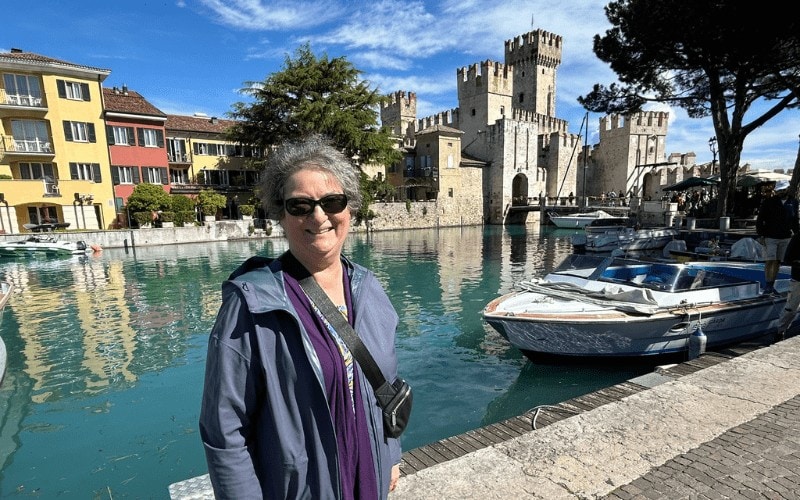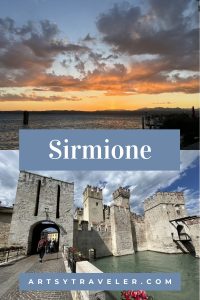Sirmione on Lake Garda: Experience the Magic of Staying Overnight
Artsy Traveler contains affiliate links for products and services I personally use and can happily recommend. As an Amazon Associate, I earn from qualifying purchases. Please read the Disclosure for more information. If you make a purchase through these links, at no additional cost to you, Artsy Traveler earns a small commission. Thank you!
The tiny resort town of Sirmione on Lake Garda in northern Italy is truly magical. Stay overnight and you’ll have the picturesque, stone-arched streets and cypress-dotted parks to yourself.
I spent 21 hours there and loved every minute of it.
In this post, I share what I did during those 21 hours, including taking a boat trip, visiting a interesting Roman archeological site, and taking peaceful walks around a peninsula that is mobbed during the day but extremely quiet and calm in the evenings and early mornngs.
Sirmione Highlights at a Glance
- Snapping photos of the very photogenic Scaligero Castle guarding the entrance to Old Sirmione
- Wandering the narrow streets in the early morning or late at night when the crowds are gone
- Visiting the Grottoes of Catallus
- Taking a boat trip around Sirmione peninsula on Lake Garda
- Staying in the stylish Hotel Flaminia
Where is Sirmione?
Located at the south end of Lake Garda, cute-as-a-button Sirmione occupies the very tippy tip of a long peninsula jutting into the lake. Lake Garda is new to me, and it certainly lives up to its reputation as one of Italy’s premier lakes. It is also the biggest lake in a country that has a lot of lakes.
Consider a trip to Sirmione if you’re en route to Venice, Verona, Milan, and other towns in northern Italy.
Arriving in Sirmione
Gregg and I drive up the peninsula to reach Sirmione (#1) at the southern end of Lake Garda. We sensibly snag a parking place outside the old town and alongside the lake, which at three o’clock in the afternoon is an unearthly shade of turquoise blue. Even in the tropics, I’ve never seen a color like it. A strong wind is sweeping the lake into a riot of whitecaps that splash sparkling billows of water against the shore.
We walk to the harbor and cross the bridge under the shadow of Scaligero Castle, which is Sirmione’s iconic medieval castle (#2) that guards the entrance to the old town. With its square towers with crenelated tops, the castle resembles exactly the kind of castle a child would draw.
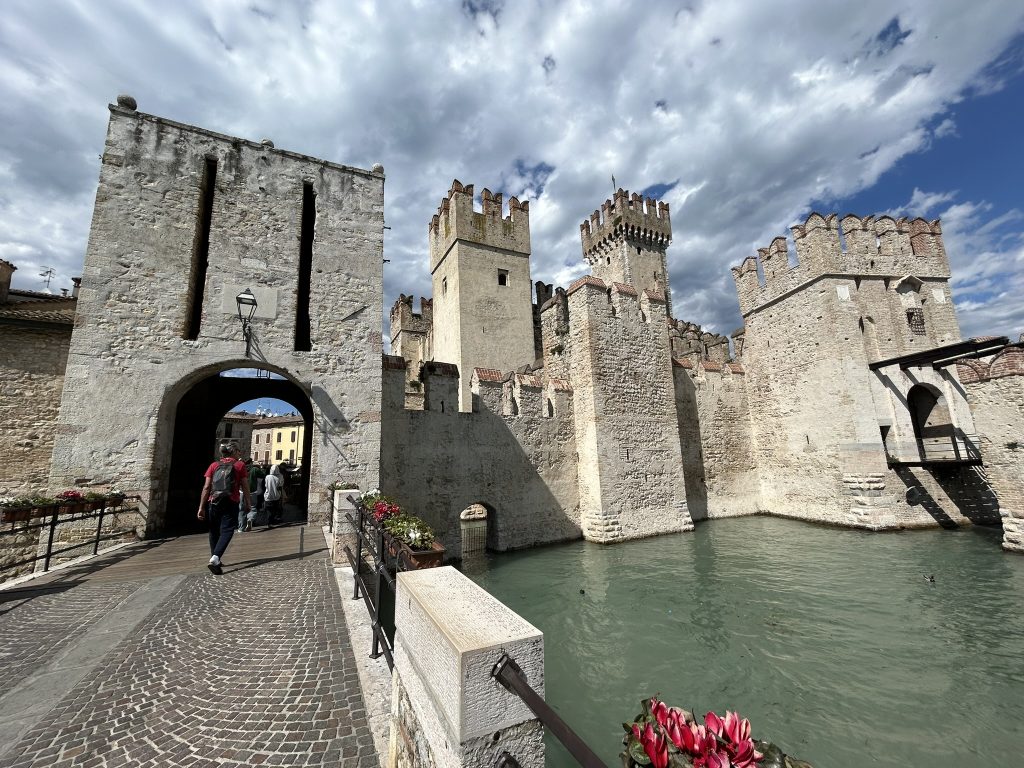
Visitors pack the streets. If it’s this crowded in April, I’d hate to see what it looks like in the summer. I have read that summer crowds can make Sirmione almost impossible to visit. Fortunately, while large, the crowds are not ridiculous. We easily navigate our way past souvenir shops and gelato places (note to self – return after dinner) to find the Hotel Flaminia.
Orientation to Sirmione
The map below shows the places mentioned in this post. Click a number for more information.
Hotel Flaminia
The three-storey Hotel Flaminia has old-world elegance and, although gorgeously situated lakeside, is not unreasonably priced at around 200 euros for the night. A highlight is the terrace that juts into the lake. In summer, you could jump right in for a swim. Although the sun is warm in April, no one is swimming so I presume the water is not yet toasty enough.
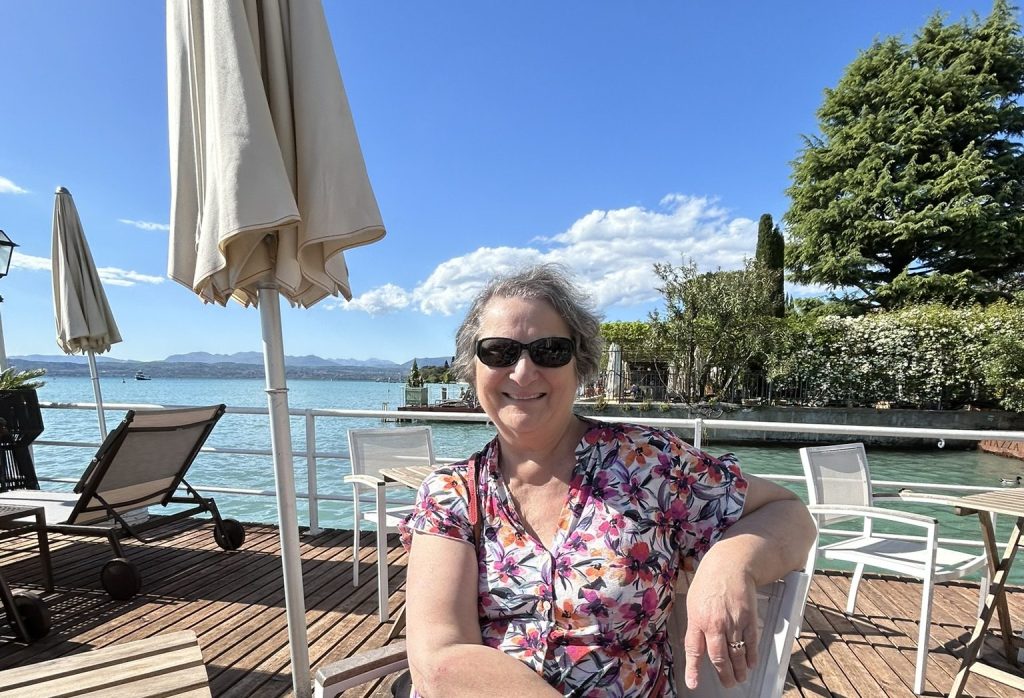
After checking into the Hotel Flaminia, we returned to our car and moved it to a gated parking lot. From there, we and our luggage rode a golf cart back into the town. Very efficient!
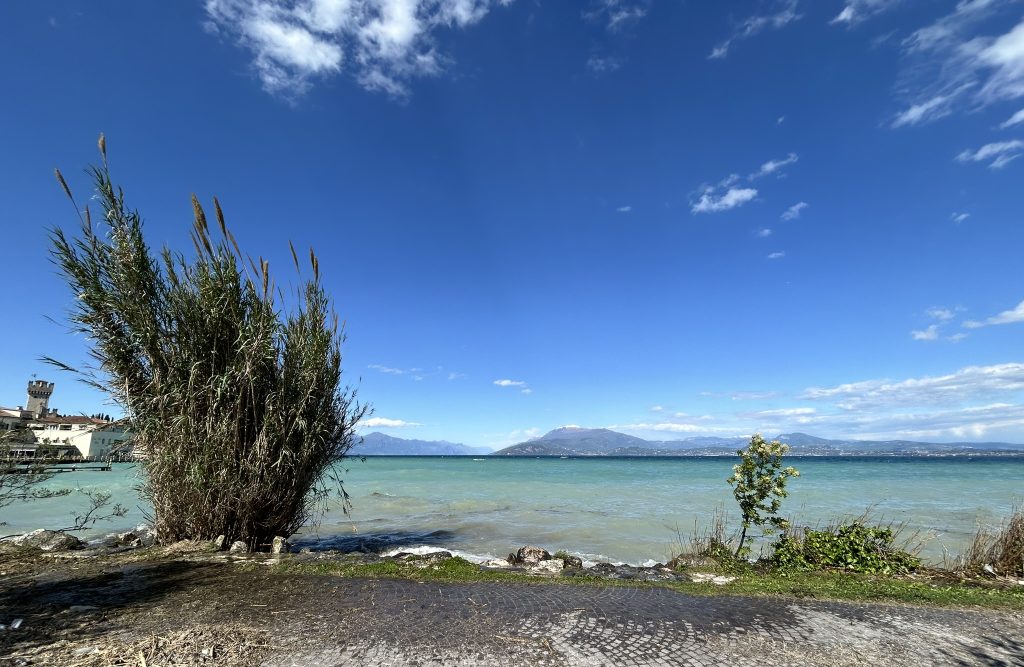
Here’s a view of the Hotel Flaminia from Lake Garda that I took the next day while on our Lake Garda boat tour.
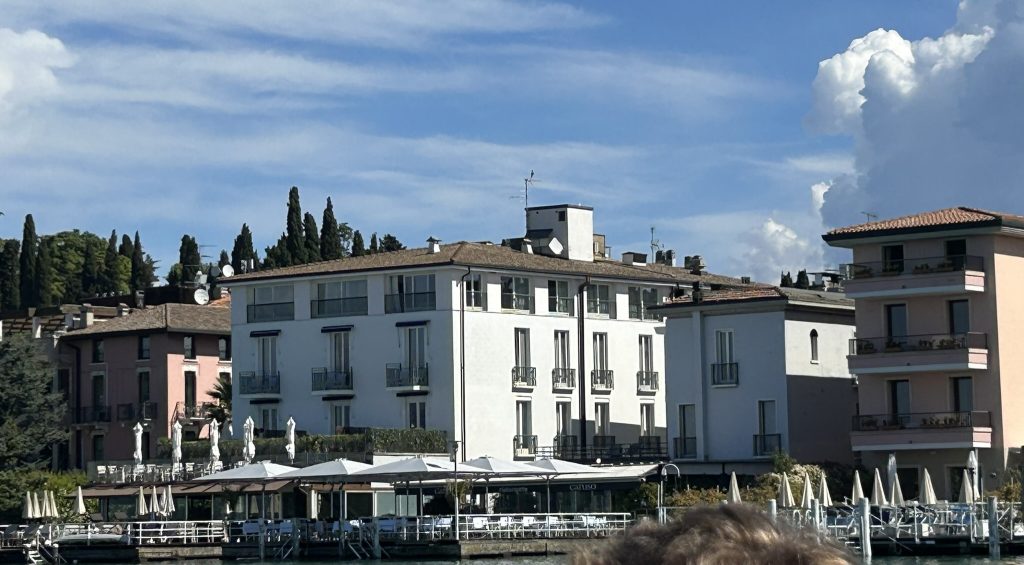
Wandering Around Sirmione
After getting settled in our lovely, high-ceilinged room, we eat a sandwich at a cafe with very friendly staff to stave off hunger (having not had much lunch).
Enjoying this post? Subscribe to Artsy Traveler to Receive Valuable Travel Tips and Your FREE Guide: 25 Must-Do Artsy Traveler Experiences in Europe for 2025

Gregg then returns to the room to recover from the six-hour drive from the French Alps and I do my favorite thing when first arriving in a new place—wandering. I set off through the maze of narrow streets to see what is at the end of the peninsula.
My walk takes me past a number of interesting shops. The usual tourist dreck packs a few of them, but several sell really nice-looking items.
I stop to covet a lemon-patterned salad bowl with matching salad tongs. If they can ship it to Canada, I just might buy it. Unfortunately, they inform me sadly that they don’t offer shipping to Canada, so I make do buying a ceramic lemon to put on my desk to remind me of Sirmione.
Maria Callas
The shops soon give way to ever larger villas, including the Termi di Catulla a complext of thermal baths, where I find a plaque honoring Maria Callas, the great opera singer.
I’d recently finished reading Diva by British author Daisy Goodwin about Callas’s life and had interviewed Daisy for The Art In Fiction Podcast a few weeks later, so I knew that Callas had once lived in Sirmione. Inside the hotel is a small display of some of her costumes and jewelry.
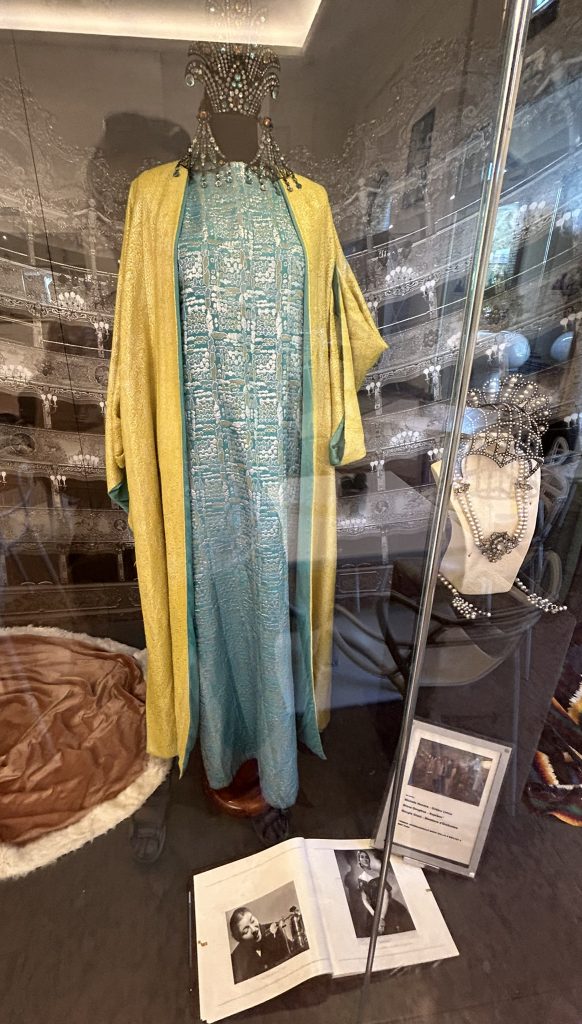
After admiring the Callas display, I carry on past Maria Callas Park to walk to the Grotto Cattalus. Along the way, I enjoy stunning views of stately cypresses, snow-dusted mountains, and wind-whipped waves. I am smitten.
Dinner in Sirmione
Dinner that evening is a charming and tasty affair. The wind is sending cutlery and napkins on the outdoor tables flying, so we opt to sit inside. Also, the evening air in April is not warm even though daytime temperatures are comfortable.
I order a shrimp tagliatelle that comes with a sauce I’d be happy to marry. Service is efficient and unsmiling. I get the impression that the staff are weary after a long day of serving tourists. Can’t say I blamed them!
I snap this photo of the setting sun as seen from the piazza just outside the restaurant.
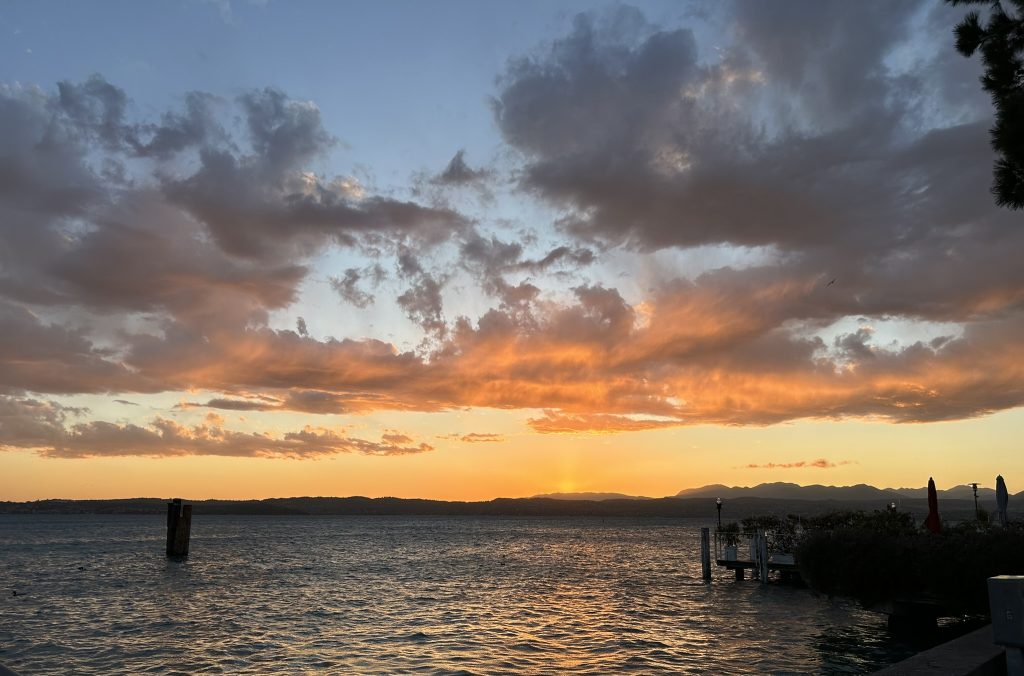
Evening Walk in Sirmione
After dinner, we scurry back to our hotel to replace my optimistic capris and sandals with long pants, socks, shoes, and a jacket, then venture out for an evening amble and to enjoy the glorious sunset over Lake Garda. Most of the tourists have disappeared, and we have the streets to ourselves.
We walk as far as the Termi di Catullo to admire the Maria Callas plaque, then return to our warm hotel room for the night.
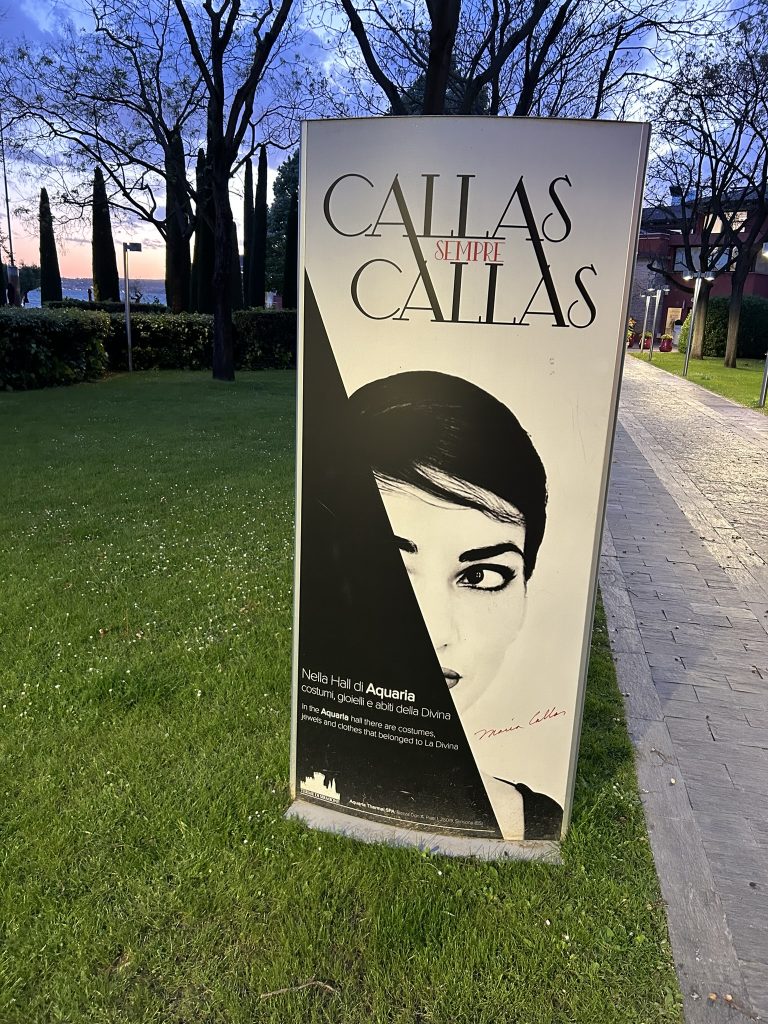
Maria Callas is not the only famous person to maintain a villa in Sirmione. Former residents include writers Ezra Pound, James Joyce, Aldous Huxley, Tennyson and Goethe. Churchill also hung out for a while in Sirmione.
A Morning in Sirmione
The next morning, we decide to enjoy Sirmione right until the noon checkout when the golf cart is scheduled to arrive at the hotel to take us back to our parking place.
The day dawns clear and warm—the complete opposite to the cloudy and chilly weather predicted on my phone.
After breakfast, we saunter out into the still empty streets and stroll all the way up the peninsula en route to visit the Grottoes of Catullus.
Villa of Maria Callus
On our way, we pass the beautiful yellow villa (#3) that Maria Callas lived in with her husband. What a place! Imagine being her neighbor back in the day and hearing her voice soaring out over the pines as she practiced her arias for a performance at La Scala in Milan, a few hours away. Talk about magical!
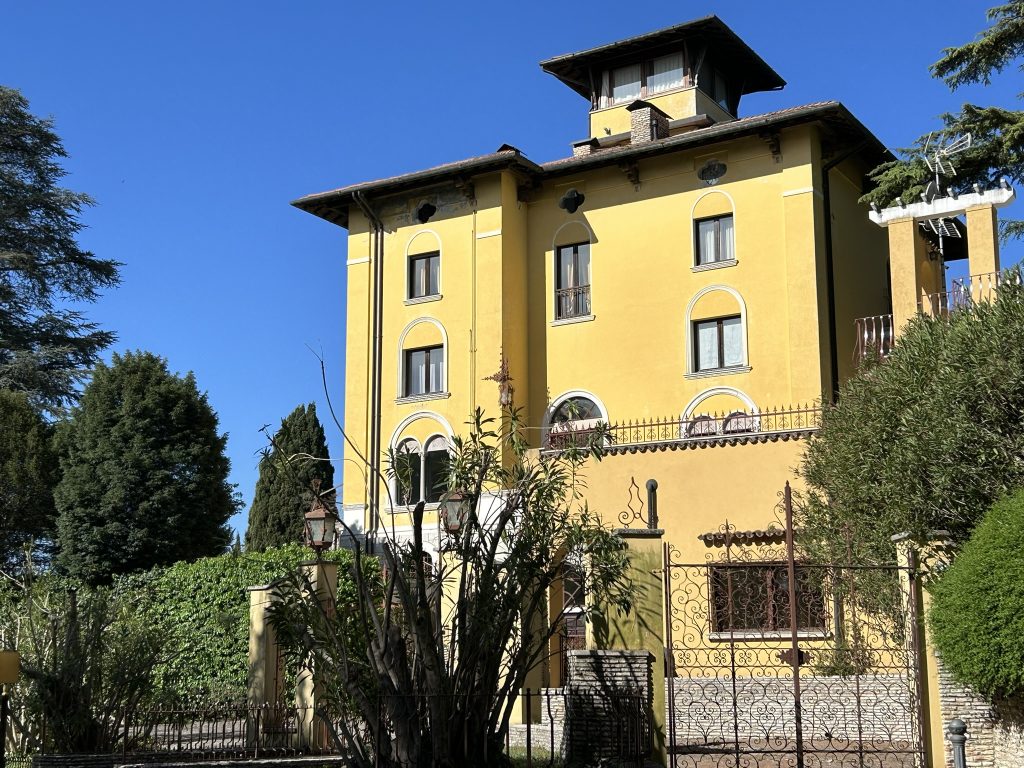
Grottoes of Catallus
The grottoes turn out to be the remains of Roman villa built between the end of the 1st century BCE and the beginning of the 1st century CE.
Called grotte di catullo in Italian, the ruins were rediscovered in the 15th century and at first resembled caves, hence the name “grottoes.” Over the centuries, archaeologists slowly unearthed a remarkable complex that must have been a Roman billionaire’s dream palace.
The grottoes were named after the poet Catullus because his poems had just been rediscovered around the time the grottoes/villa was found. In his 31st poem, Catullus described love of his beloved house in Sirmione. He wrote:
Sirmio, jewel of islands, jewel of peninsulas, with what joy, what pleasure I gaze at you.
Despite his raving about the place, there is no evidence linking Catallus to this particular villa, mostly because he died before it was built.
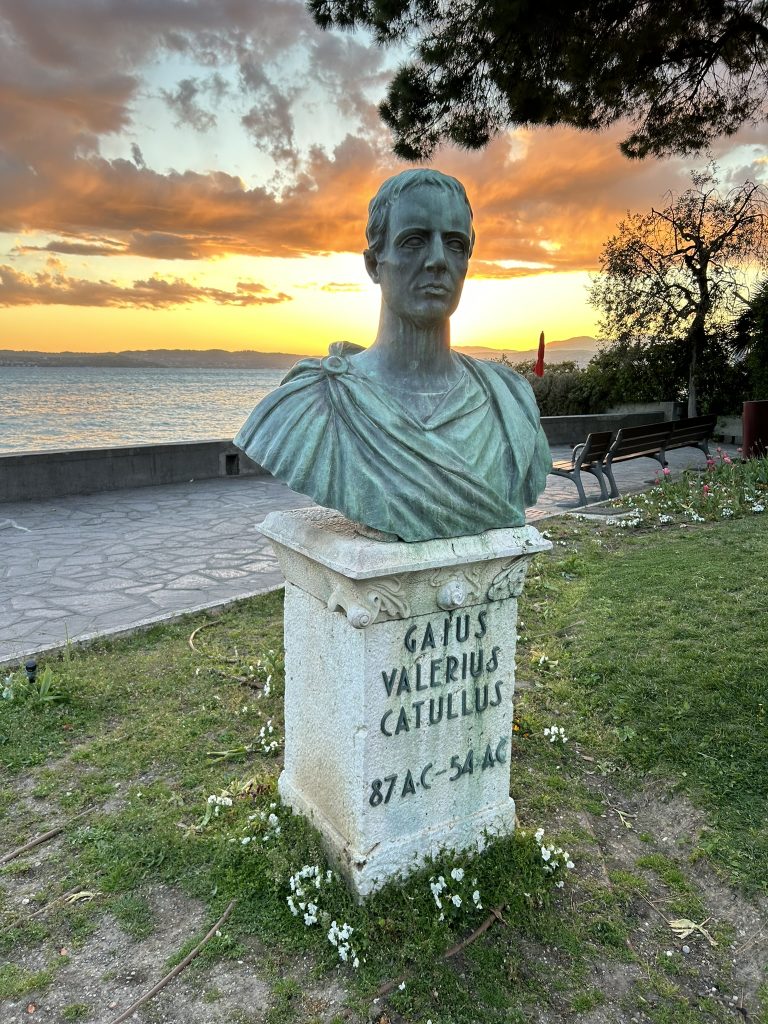
Anyway, the name stuck, and wow—the site is definitely worth a visit. The villa is situated on a promontory at the very top of the peninsula with stunning views of the lake and mountains.
On a warm and breezy April day with few other tourists around, enjoying the lake views during a leisurely ramble among olive groves atop the ruins are an artsy traveler’s dream come true.
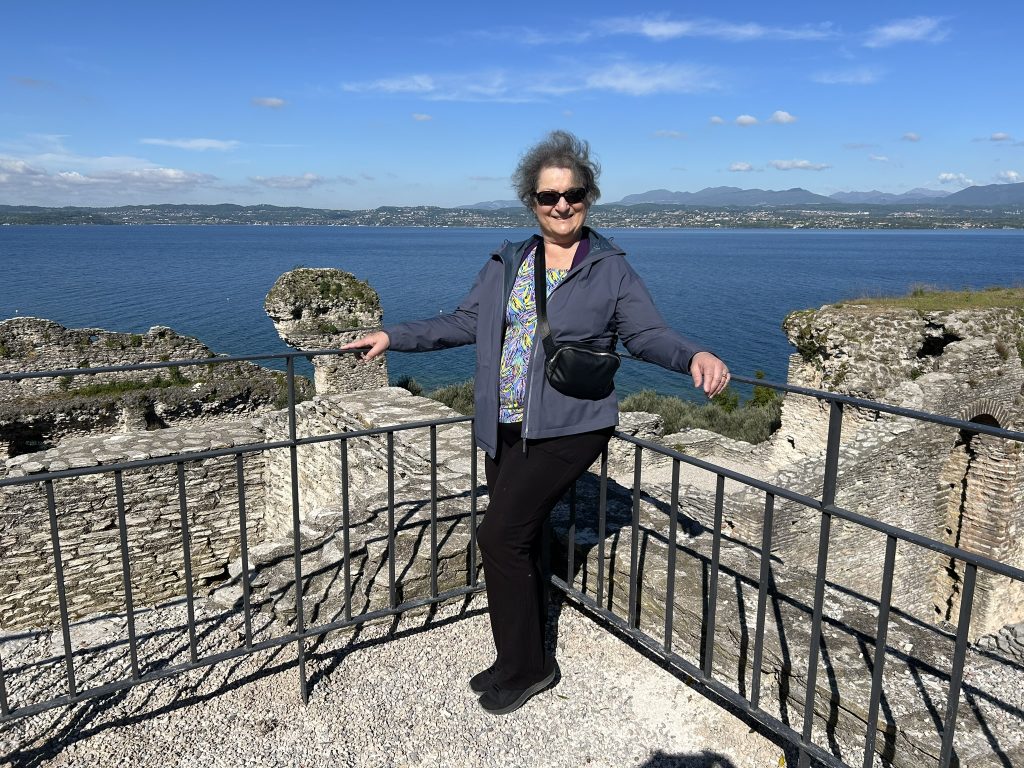
Video of the Panorama
Here’s a video that captures the sublime view above the Roman ruins.
We happily snap many photos, and then descend to the museum. Unfortunately, several school groups have just arrived, and despite the many attempts of shushing by the teachers, fill the small space with their chatter.
How wonderful it must be to grow up in a country where school outings take you to a Roman villa! One little girl looks up at us as we pass and cheerfully wishes us buon giorno.
We do a quick walk through the museum. It is small but filled with some good-looking frescoes and various finds from the archaeological dig.
Don’t Miss the Shuttle!
After our visit, we catch the little shuttle that ferries visitors from the site back to the Termi di Catullo for a mere €1.20 each.
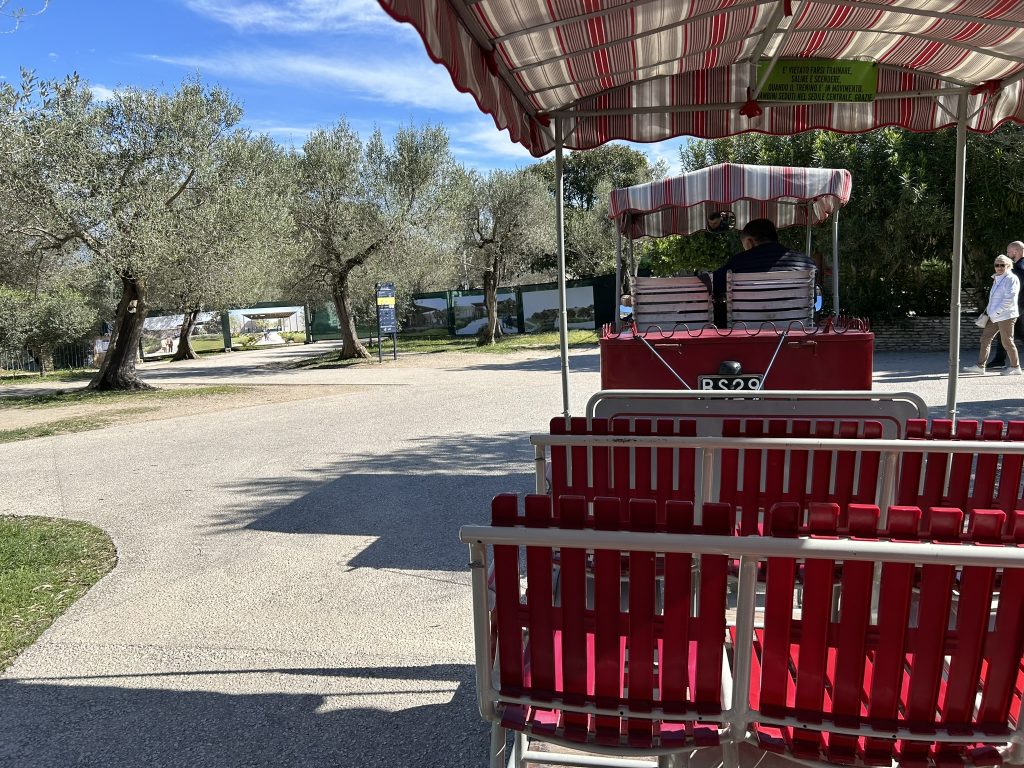
Our next stop—a lake cruise!
Cruise on Lake Garda
We walk out to the tiny harbor at the foot of the castle and easily find the blue umbrella at the Lake Garda Tours kiosk. At the time of our visit, two tours are available—at 11 am and 5 pm. I booked the earlier tour the night before.
We quickly check in and promptly at 11 am, about 15 of us are taken to a spacious open boat with comfortable seating that ensures spectacular views of the lake and Sirmione.
Enjoying the Cruise
The tour around the peninsula really is delightful. We motor up the west side of the peninsula past the Villa Flaminia and many other gorgeous villas. The guide points out Maria Callas’s distinctive yellow villa that we saw earlier that morning.
Here’s a video taken from the boat.
We round the top of the peninsula and enjoy the view of the impressive ruins at the Grottoes of Catallus (#4) that we just toured.
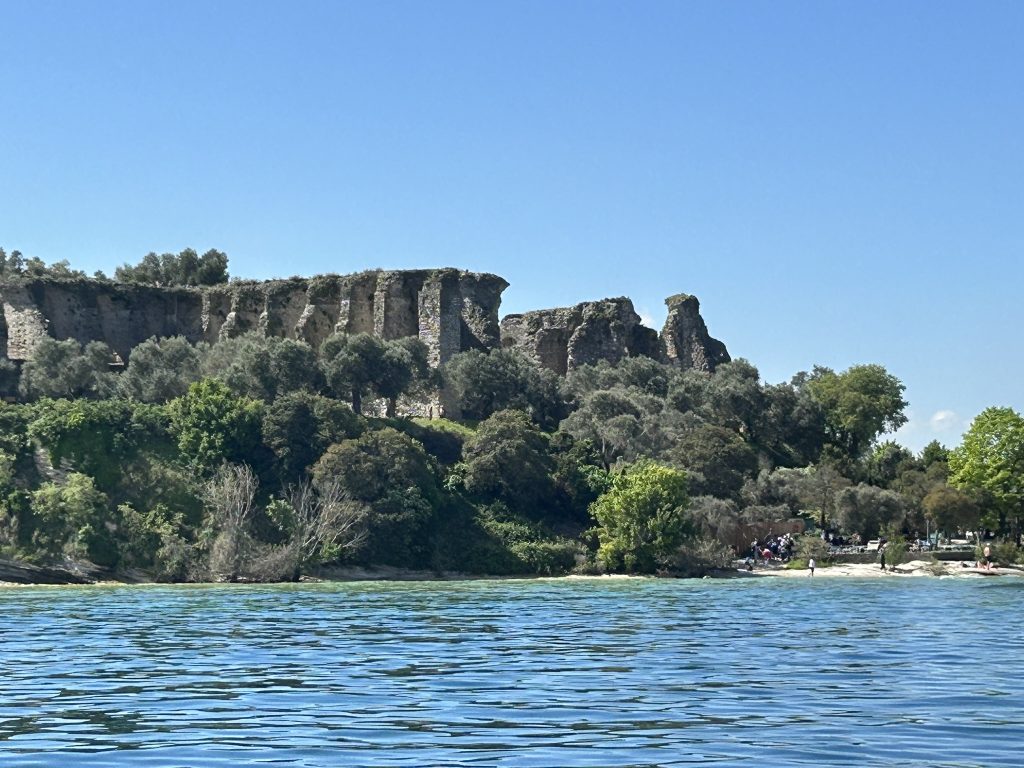
On our way down the east side of the peninsula, the skipper stops the boat and points out the bubbles in the water. Apparently, they are the result of hot springs far below, gurgling away at 70 degrees centigrade which is pretty darned hot.
One of the reasons that Sirmione has been so popular over the millennia is the thermal hot springs. Imagine all those retired Roman generals coming here for spa days to soothe their battle-wearied bones.
At the end of the tour, we all bend very low to cruise beneath a small bridge connecting the old town and castle area to the rest of the peninsula. The whole experience is thoroughly enjoyable on a breezy and bright April day.
I highly recommend a boat trip as one of the top things to do in Sirmione!
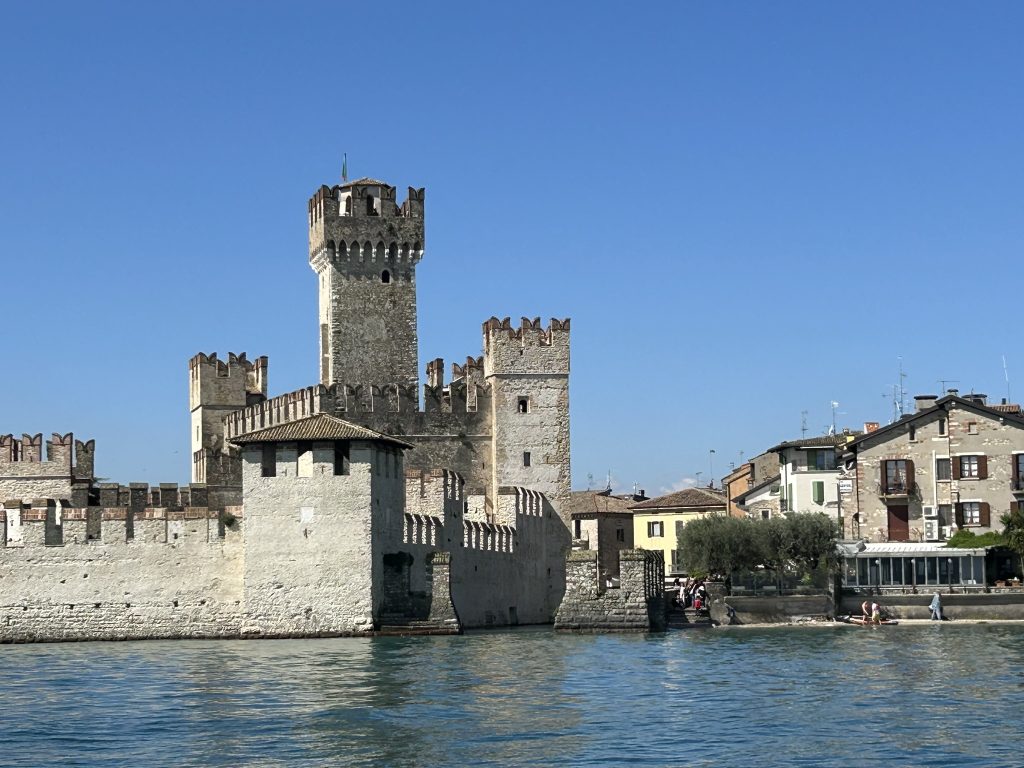
Farewell to Sirmione
After the cruise, we duck around the crowds to return to the Hotel Flaminia where, precisely at noon as booked, the golf cart rounds the corner into the Piazza Flaminia. Moments later, we and our luggage are loaded aboard and off we go to where we parked the car.
Our visit to Sirmione has been short but definitely worthwhile. I’d like to return in the summer to explore Lake Garda and also to swim in the lake, which is allegedly fantastic, although the crowds are even denser.
However, even in summer, if you stay overnight you’ll likely have the streets to yourself in the evening and early morning, which more than makes up for having to dodge fellow tourists during the busy midday hours.
Staying in Sirmione
Sirmione has plenty of hotels to choose from. You can sleep in the old town like we did (recommended), choose a place along the lake shore that stretches either side of the peninsula, or select one of the many hotels located on the long road that bisects the peninsula to end at the bridge leading to the town.
The Hotel Flaminia where we stayed is elegant, perfectly located, and not too expensive.
Most of hotels in the old town are pretty pricey, with rates at some of the five-star villas stratospheric. Check Trip Advisor and Booking.com for options.
Parking Considerations
If you choose a hotel outside the town walls, you’ll either need to walk a long way or drive to the parking lots on the peninsula that I should imagine in summer fill up very fast. Even in April, we had to park quite a long way from the entrance to the town.
I’m so glad we chose a place in the old town. The Hotel Flaminia offered parking for an extra 16 euros in a lot outside the walls and as mentioned, threw in transport via golf cart from the car park to the hotel.
Before you book, check the parking situation. You definitely don’t want to book a hotel that requires you to drive into the old town. I felt sorry for the people inching their cars through the extremely narrow streets en route to their hotels.
Other Tours Around Sirmione
I’m a big fan of GetYourGuide tours. I’ve consistently found them to be good value for money. Here are links to more Get Your Guide tours from Sirmione:
You can also purchase tickets and tours through Tiqets.com, another company I use frequently.
Conclusion
Have you visited Sirmione? Where did you stay? What did you do? Share any information that may interest other artsy travelers in the comments below.
Here are some more posts about travels in Italy:
